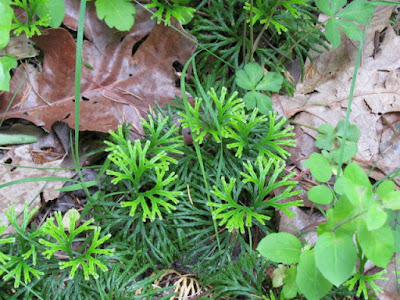While hiking recently I got to thinking about the various plants that stick to our sock and pants. Certainly, they are frustrating; but, as a plant geek, I wanted to know more.
Sticky plants attaching to clothes, hair, fur, and feathers to disperse their seeds into new areas. They do this with hooks, spines, barbs, and burrs. Let’s look at a few common examples that we find here in central Illinois.
The biggest challenge on my property is Spanish Needles (Bidens bipinnata). This weedy plant grows one to three foot tall in dry, shady areas. Its leaves are finely textured, looking a bit like flat-leaved parsley. The non-showy, yellow flowers develop into 2-4 prong, barbed fruit. They get their name from the fruit’s needle-like prongs, each with its own backward pointing barb.
Virginia Stickseed (Hackelia virginiana), also
called beggar’s lice, has very small prickly bur fruit that clings to clothing.
It grows one to four foot tall in dry woods. The burs are less than ¼” in size.
Burs are arranged along one side of stems (racemes) that are held 2-8” above
the plant.Virginia Stickseed
Probably the most commonly known hitchhikers are burdock and cocklebur. In fact, Velcro is said to have been designed after the burs of the burdock plant. After a hunting trip, the inventor looked closer at the tiny hooks on the bur and created the hook and loop fasteners design.
 |
| Cocklebur |
Cocklebur (Xanthium sp.) is related to burdock. This plant sprouts from seed each year, reaching 2-5 foot by summer’s end. Its triangular, lobed leaves are 2-6” long. Cocklebur has both male and female green colored flowers. Female flowers form ½-3/4” burs that are held in the axils of the leaves. The football-shaped burs cling with hook-tipped prickles.
 |
| Bedstraw |
Bedstraw (Gallium sp.) is sometimes called velcro-plant or stickywilly. Bedstraw attached to us in two ways. Its leaves and stems have fine hook-like hairs that cling to clothing and fur. However, it is the extremely small seeds that really create havoc. At less than 1/25 of an inch, the seed burs are covered with small hooked bristles. Because each plant produces hundreds of seeds, they quickly cover large areas of clothing. Their small size and abundance make them difficult to remove.
There are many more, but you get the idea. I have not developed a magic way for removing these from my clothes or pet’s hair. Washing clothes does not remove most hitchhiker seeds. They usually need to be picked off individually, though some can be scraped off with a butter knife.
Enjoy a fall hike in the woods, but try to avoid those hitchhikers!
Published in Canton Daily Ledger Column 11-4-2017










